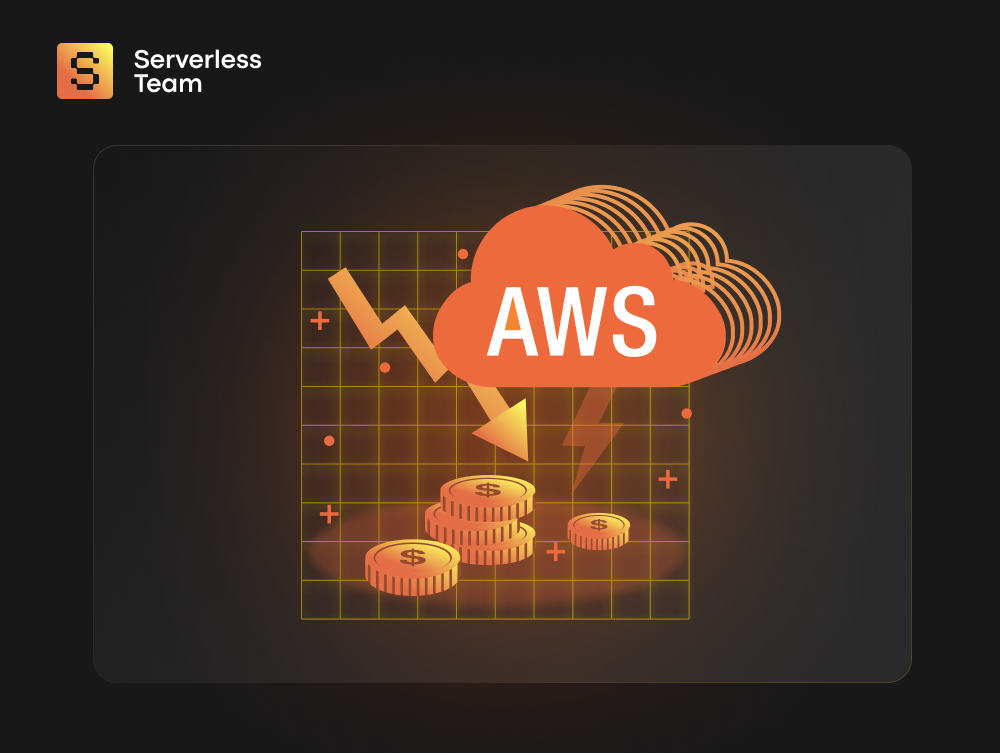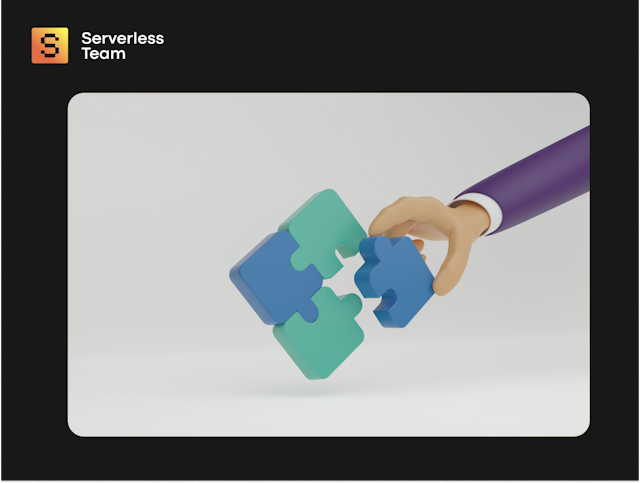Moving your software to the cloud may feel like leasing a Manhattan loft with a view over Central Park: it’s good for your heart & soul but bad for your wallet. And soon enough, maintaining this lifestyle gets out of hand, and the bills suddenly stop making sense... and you just want all of it to stop. With the right cloud cost optimization techniques, you can sustain the allure of this lifestyle avoiding the overwhelming expenses.
Let me tell you, keeping track of your infrastructure budget is tough, especially for a growing business. According to Anodot's 2023 report, many businesses struggle with this task. While 67% of respondents reported that less than a third of their cloud spending is wasted, 20% remain unaware of their cloud waste.
But worry not: Serverless Team is an expert in AWS cloud cost optimization techniques, demonstrated through over 200 successfully completed serverless projects. In this article, I'll guide you through how we at Team Serverless think it's best to go around optimizing your cloud costs.
And if you need more than an article, we briefly describe how we help our clients with cloud cost optimization in the Milnorway case study, where we were migrating a product from a Chinese cloud platform to AWS Serverless.

We take care of serverless development so you can focus on your business
Don't want to wait for our site launch? Let's talk about your idea right now.


Why is Cloud Cost Optimization Important?
Cloud cost optimization is vital for businesses striving to maximize their resources while minimizing expenses efficiently. What are the most common cost drivers that lead to overspending if not appropriately managed?
At Team Serverless, we recognize two types of reasons: one has to do with how an organization is structured, and the other has to do more with cloud resources & providers. Let's take a look:

Reasons related to your organization & how you handle things
-
Improper Pricing Model Selection
Pretty obvious, but I have to put it out here because it gets overlooked quite often: choosing the wrong pricing model for cloud services results in overspending. For example, opting for on-demand instances instead of reserved instances for stable workloads will dry your budgets over time.
-
Lack of Usage Monitoring and Governance
Poor visibility into cloud resource usage can make it challenging to identify overspending areas. Crazy, right? But also difficult to keep in mind. Monitoring cloud services and implementing proper governance practices, such as tagging resources, is necessary to track and optimize costs. Enforce these practices from the start to spend wisely.
-
Inadequate Cost Allocation
Hanging money on a growing project takes a lot of work. You want the best, the fastest, the most scalable of them all. Without proper cost allocation practices, it becomes difficult to attribute costs to specific teams, projects, or departments. This lack of granularity can lead to overspending without clear accountability.
-
Lack of Cost Optimization Strategies
Failing to implement cost optimization strategies, such as rightsizing resources, using spot instances or spot blocks, implementing caching mechanisms, or leveraging cost-effective alternatives, leads to overspending. And I know doing all this homework and addicting additional steps to your checklists can be a pain. But trust me — the result is worth it.
Reasons related to cloud services and providers
-
Unused Resources
This is first and foremost. If you want to know where your precious money goes, check for instances, storage, and other running cloud services that have yet to actively serve any purpose. Just like Liam Nison said — find them and end them.
-
Overprovisioning
It’s simple: don’t bite more than you can chew. It's essential to accurately assess the required capacity and choose appropriately sized instances and storage to avoid paying for resources you don’t use.
-
Lack of Resource Optimization
Using your resources inefficiently leads to increased costs. So to avoid that, you must establish some ground rules and include performance audits and optimization in your quarterly plans.
-
Data Transfer and Network Costs
Excessive data transfer between different services, regions, or external networks can contribute to overspending. Check for inefficient data transfer patterns, unoptimized network configurations, or unnecessary bandwidth allocation to save up.
-
Unoptimized Storage
Are you using your storage efficiently? Check for whether you're storing redundant or infrequently accessed data in expensive storage tiers, as it can really cut down that check at the end of the month. To optimize your storage costs further, employ data lifecycle management strategies and ensure you're utilizing the appropriate storage classes.
-
Complex Pricing Structures
Let's be honest, with an abundance of cloud providers & offers like various pricing models, discounts, and pricing tiers, it's not easy to find what matches your needs. But Team Serverless is always here to consult if you need some advice. Just give us a call.

Kyrylo Kozak
CEO, Co-founderGet your project estimation!

Top 10 Cloud Cost Optimization Best Practices
Optimizing costs in the cloud involves steps that help identify inefficiencies, eliminate wasteful spending, and maximize the value of your cloud resources. Here are ten steps top serverless development companies recommend to implement to start saving money on your cloud resources as soon as possible:

1. Learn More About Cloud Cost Optimization
Begin by familiarizing yourself with cloud cost optimization principles and best practices. Gain an understanding of the different pricing models, resource allocation strategies, and optimization techniques specific to your cloud provider. Let’s review it in detail.
- Familiarize yourself with pricing models: Explore various pricing models offered by your cloud provider, including pay-as-you-go, reserved instances, and spot instances. Understand the cost implications of each model and how they align with your workload requirements.
- Study resource allocation strategies: Dive into resource allocation strategies tailored to your specific cloud environment. Learn about techniques such as rightsizing, workload consolidation, and dynamic resource allocation to optimize resource utilization and minimize costs.
- Explore optimization techniques: Learn more about techniques such as auto-scaling, containerization, and serverless cost optimization. Understand how these techniques can improve operational efficiency and reduce costs by aligning resource usage with demand.
2. Analyze Your Cloud Usage
Look at your cloud usage patterns and identify areas where you can improve. Look for overprovisioning, underutilization, and potential inefficiencies in resource allocation. Here is how you can approach it.
- Identify overprovisioning: Analyze resource usage data to identify instances of overprovisioning. Where are resources allocated in excess of actual requirements? Look for opportunities to rightsize resources and eliminate waste.
- Address underutilization: Identify instances and services that are underutilized or dormant, adding unnecessary costs. Implement strategies to consolidate resources, optimize configurations, and improve utilization rates.
- Optimize workload placement: Analyze workload placement across cloud services and regions to minimize costs while meeting performance requirements. Consider latency, data sovereignty, and regulatory compliance in your optimization efforts.
3. Identify Idle Resources
Spot out any idle or unused resources in your cloud environment. These can include idle instances, storage volumes, and databases that consume resources and incur costs without delivering value. Terminate or reallocate these resources to eliminate unnecessary expenses. Here is how:
- Implement resource tagging: Tag resources with metadata to track ownership, usage, and cost allocation. It will help you identify idle resources and take appropriate action, such as termination or reallocation.
- Utilize cloud monitoring tools: Use tools to track resource utilization metrics in real-time. Set up alerts for idle resources or abnormal usage patterns to prompt timely intervention and cost optimization.
- Establish resource lifecycle policies: Define policies for resource lifecycle management, including provisioning, usage, and decommissioning. Automate the enforcement of these policies for timely resource cleanup and cost optimization.
4. Optimize Your Cloud Storage
Review your cloud storage usage and identify opportunities for optimization. Archive data based on usage patterns and cost implications. Compress and deduplicate data where applicable to reduce storage costs. Here is how you can do it:
- Classify data types: Sort data based on usage patterns, access frequency, and retention requirements. Determine the appropriate storage tier for each data type to optimize storage costs.
- Compress and deduplicate data: Use data compression and deduplication techniques to minimize storage footprint and reduce storage costs. It can lead to significant savings, especially for large datasets and archival storage.
- Implement storage lifecycle policies: Utilize storage lifecycle policies to automate data archival, tiering, and deletion. Set up policies based on data age, access frequency, and regulatory requirements to optimize storage costs.
5. Take Advantage of Reserved Instances
Look at cloud providers' reserved instances offerings and analyze your workload requirements to purchase reserved instances for predictable and steady workloads. Here's how you can benefit from reserved instances:
- Analyzing workload patterns: Examine your workload requirements and usage patterns to determine the most suitable reservation options. Consider instance type, region, and term length to maximize cost savings while meeting performance requirements.
- Use reservation utilization reports: Check reservation utilization reports provided by your cloud provider to track reservation usage and identify opportunities for optimization. Monitor reservation utilization over time and adjust reservation coverage as needed to avoid underutilization or overcommitment.
- Implement reservation recommendations: Use your cloud provider’s reservation recommendations to optimize reservation coverage and maximize cost savings. Consider recommendations for converting on-demand instances to reservations or modifying existing reservations to better align with workload requirements.
6. Look Into Spot Instances
Consider using spot instances for non-critical workloads that can tolerate interruptions. Spot instances are available at significantly lower prices compared to on-demand instances. You can achieve substantial cost savings by using spot instances, especially for fault-tolerant or flexible workloads. Here's how to leverage spot instances effectively:
- Identify suitable workloads: Determine workloads that can tolerate interruptions and are suitable for running on spot instances. Consider workload characteristics, tolerance for downtime, and cost sensitivity.
- Monitor spot instance pricing: Check spot instance pricing and availability to identify cost-effective opportunities for spot instance usage. Use historical pricing data and spot instance market trends to inform decision-making and optimize cost savings.
- Implement fault-tolerant architectures: Design fault-tolerant architectures that can handle spot instance interruptions. Use workload checkpointing, stateless application design, and automated failover to minimize disruption and maintain availability.
7. Review Your Cloud Network
Ensure your network design aligns with your requirements, eliminating unnecessary components or data transfer costs. Implement efficient network routing and traffic management strategies to minimize costs. Here is how to optimize your cloud network:
- Evaluate network topology: Assess your network topology and architecture to identify inefficiencies, bottlenecks, and opportunities for optimization. Consider network latency, bandwidth utilization, and data transfer costs in your analysis.
- Optimize network routing: Refine network routing and traffic management to minimize costs. Implement efficient routing policies, traffic shaping, and load balancing techniques to optimize resource utilization and reduce data transfer costs.
- Leverage cloud networking services: Utilize cloud networking services and features provided by your cloud provider to optimize network performance and cost efficiency. Explore virtual private clouds (VPCs), content delivery networks (CDNs), and peering connections to optimize network connectivity and reduce latency.
8. Use Automation
Your cloud provider's automation tools and services are there for a reason. They help to streamline processes and optimize resource management. If you want to save money, go ahead and automate the provisioning and de-provisioning of resources, implement auto-scaling mechanisms, and use infrastructure-as-code practices. It will pay off in no time.
- Automate provisioning and de-provisioning: You can do it using infrastructure-as-code (IaC) tools and automation scripts. Use templates and configuration management tools to automate resource deployment and teardown processes. It will reduce manual effort and minimizing errors.
- Implement auto-scaling mechanisms: This way you can dynamically adjust resource capacity based on workload demand. Use predictive scaling algorithms, threshold-based triggers, and workload profiling to automate resource scaling and optimize cost efficiency.
- Adopt DevOps practices: Adopt continuous integration (CI) and continuous deployment (CD) to automate software development, testing, and deployment processes. Use automated testing, deployment pipelines, and release automation tools to accelerate software delivery and optimize resource usage.
9. Monitor Your Cloud Usage
Implement monitoring and analytics tools to gain visibility into your cloud usage and spending. Continuously monitor resource utilization, performance metrics, and cost trends. Use this data to identify anomalies, optimize resource allocation, and make informed decisions.
- Define key performance indicators (KPIs): KPIs and metrics help to track resource utilization, performance, and cost trends. Identify relevant metrics based on your business objectives, workload characteristics, and cost optimization goals.
- Implement real-time monitoring: Real-time monitoring and alerting systems detect anomalies, performance degradation, and cost overruns in your cloud environment. Set up automated alerts and notifications for threshold breaches, abnormal behavior, and cost spikes to prompt timely action.
- Leverage analytics and reporting: Analyze historical usage data, identify cost optimization opportunities, and track progress towards cost reduction goals. Use dashboards, reports, and visualization tools to gain insights into resource utilization patterns, cost trends, and optimization recommendations.
Discover more cloud app monitoring tips in our blog.
10. Make Sure to Review Your Cloud Costs Regularly
Regularly review and analyze your cloud costs to identify trends, patterns, and areas for improvement. Conduct cost reviews on a monthly or quarterly basis, involve relevant stakeholders, and adjust your optimization strategies accordingly. It’s a must for cutting cloud costs. Here's how to conduct regular cost reviews effectively:
- Set up cost review cadence: Establish a regular cadence for conducting cost reviews, such as monthly, quarterly, or annually, depending on your business needs and budget cycle. Define roles and responsibilities for cost review activities and involve relevant stakeholders from across your organization.
- Conduct comprehensive cost analysis: It will help you identify trends, patterns, and areas for improvement in your cloud spending. Review cost breakdowns, usage reports, and billing statements to understand cost drivers, identify cost-saving opportunities, and track progress toward cost reduction goals.
- Optimize cost allocation and chargeback: It will ensure transparency, accountability, and cost awareness across your organization. Implement cost tagging, showback reports, and cost allocation models to allocate costs accurately, attribute costs to relevant stakeholders, and promote cost-conscious behavior.
- Iterate and improve: Continuously iterate and improve your cost optimization strategies based on feedback, lessons learned, and changing business requirements. Incorporate insights from cost reviews, stakeholder feedback, and industry best practices to refine your cost optimization approach over time.
Cost Performance Indicators to Keep an Eye On
My team was set on including a list of the most important KPIs you can track and measure to ensure you use your resources efficiently. So here they are:
-
Total Cost of Ownership (TCO):
Measures the overall cost of cloud services compared to on-premises alternatives.
-
Cost per workload/user/transaction:
Evaluates the cost efficiency of individual workloads, users, or transactions in the cloud environment.
-
Resource Utilization:
Monitors CPU, memory, and storage utilization levels to ensure efficient resource allocation.
-
Service Availability:
Measures the uptime and availability of cloud services to ensure they meet the defined service-level agreements (SLAs).
-
Performance Metrics:
-
Average Response Time: Measures a system or service's time to respond to a request.
-
Latency: Measures the delay between sending a request and receiving a response.
-
Throughput: Measures the rate at which a system or service can handle incoming requests.
-
-
Scalability and Elasticity:
-
Auto-scaling Events: Tracks the frequency and effectiveness of automatic scaling events based on demand.
-
Time to Scale: Measures the time it takes to scale resources up or down to meet workload requirements.
-
Resource Provisioning Time: Measures the time it takes to provision new resources in the cloud environment.
-
-
Security and Compliance:
-
Security Incidents: Tracks the number and severity of security incidents and breaches.
-
Vulnerability Management: Measures the effectiveness of vulnerability management processes.
-
Compliance Adherence: Ensures compliance with relevant industry standards and regulatory requirements.
-
Conclusion
In conclusion, optimizing cloud costs is a crucial aspect of managing your cloud infrastructure. This article has covered various strategies and best practices for saving big bucks on cloud cost optimization. Plus, we also highlighted the common cloud cost drivers and provided a list of key performance indicators to monitor.
And sure, while implementing these cost optimization strategies can lead to significant savings and improved cost predictability, it’s an ongoing process that requires non-stop effort. That's where our expertise comes in.
At Team Serverless, we specialize in helping businesses optimize their cloud costs. Our team can conduct a comprehensive audit of your cloud infrastructure, develop a customized cost optimization strategy and guide you through choosing the right pricing models for your business.
If you need further guidance or have specific questions about your app's architecture, our team is here to assist you. Reach out, and let’s together choose what architecture suits your app best.





